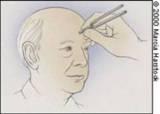Conductive hearing loss
Is caused by a disorder of the external & middle ear
Usually does not excess 60 dB
Etiology
- Occlusion of EAC
- Perforated of the TM
- Occlusion of eustachian tube
- Fixation of the ossicular chain c or s fixation of ear drum
- Discontinuty of the drum ossicle chain mechnism
- Congenital malformation
Occlusion of EAC
Occlusion of EAC may be result from
- Congenital atresia
- Acquired atresia from External otitis or trauma,FB or
Impactcerumen,Furuncle, Polyp,exostosis,Neoplasm
Restoration of normal hearing can be expected after removal of the
obstruction
Perforated of the TM
Degree of HL depend on size,location & nature of perforation
Caused by trauma,after an acute necrotic OM
Usually low frequency loss
Occlusion of eustachian tube
Hypertrophy of nasopharyngeal adenoid tissue
Allergic tubutympanitis,scars of tube orifice
Acute viral or bacterial nasopharyngitis
Descent in plane,train,deep sea diving->barotrauma or aero-otitis
Cleft palate,both before and after surgical repair
Tumor of nasopharynx
Malocculsion of mandibular jt (Costens syndrome)
Fixation of the ossicular chain c or s fixation of ear drum
Decreased of mobility of ossicular chain from fixation
Otosclerosis, tympanosclerosis, scar after sergery or infection
Can evaluated by pneumotic otoscope
Reconstruction ex Stapesdectomy in otosclerosis
Discontinuty of the drum ossicle chain mechnism
Infection or trauma
Incudostapedial joint floating in middle ear à increased risk of
devascularized of its
Evaluated by pneumatic otoscope or tympanogram
Occurs maximum CHL by normal TM
Diagnosis
History
Physical examination
- Otoscope (Diagnosis,Pneumatic)
- Tuning fork test (Rinne, Weber test)
- Audiometry
- Tympanometry
History and physical examination for hearing loss
Onset
Age at onset
Abrupt versus gradual
Progressive, intermittent, or continuous
Antecedent illness
Duration of symptoms
Associated symptoms
- Tinnitus
- Dizziness or vertigo
- Aural fullness
- Pain
- Allergy symptomatology
- Actions that change intensity of symptoms
- Distorted auditory perception
- Worsening with pregnancy or oral contraceptive use
Family history of hearing loss
Occupational noise exposure
Recreational noise exposure
Trauma
Surgical history
Previous or current draining from ear
Systemic infections and treatments
Previous use of a hearing aid
Ototoxic medications
- Cancer chemotherapy
- Antibiotics
Recent air travel
Recent underwater diving
Tuning fork test
False negative Rinne test
- When there is total or severe SNHL in one ear
- The vibrations of the tuning fork are transmitted across the bone of the
skull and are sensed by the opposite and healthy cochlea


Table 147-2. Degree of hearing loss estimated by Rinne testing
Rinne test result
|
Estimated conductive loss
|
| Negative, 256 Hz Positive, 512 and 1024 Hz |
Mild conductive loss of 20-30 dB |
| Negative, 256 and 512 Hz Positive, 1024 Hz |
Moderate conductive loss of 30-45 dB |
| Negative, 256, 512, 1024 Hz |
Severe conductive loss of 45-60 dB |
Summarized By Thirayost Nimmanon
โดย ธีรยสถ์ นิมมานนท์
 
| 